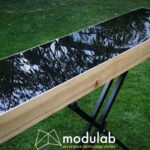Looking for hands-on applications I met with the Modulab team. There I got a job as a Junior Hardware Engineer by presenting them my prototyping projects such as slither DOT. Being integrated into the Modulab team from mid-2016 till early 2019 allowed me to work in a boundary region I thrived so much for, specifically between art and technology. I developed with them lots of projects such as mind battle and mind cars, two-players games controlled with neural headsets or smart ear tag for bison, a tracking device for bison. Even if my main skill was hardware engineering, I also gathered knowledge in programming, product design, materials, and mechanical engineering which were later priceless when I started working on my own company, Embeto Electronics.
During the same period, in the summer of 2017, I was an intern at Amiq Consulting, a Functional Verification Company based in Bucharest. Even if verification had little to do with hardware engineering, I met passionate people who guided me through the design of a project I had under development at that time, SMSGate. At the end of my internship, I also wrote an article on the Amiq Blog.
Even if I was working for Modulab during this period, I also established my own company, Embeto Electronics when I started working on projects with other customers such as Father, a Research and Development Company for whom I developed a smart cane for VI. Another big part of my company was its laboratory, documented separately on the Workspace page. Starting from a blank space I assembled a fully functional electronics laboratory. Projects specifically designed for my laboratory were reflowster, a reflow oven consisting of a hacked electrical one, or sigGen200 a custom-made signal generator.
In late 2018 I had the idea of a new and challenging project, Centenescu, a bracelet-symbol of the Romanian Centenarian, followed by a similar idea, Bradescu, a Christmas tree, both made of bare PCB. I learned then how complicated selling a ready-made product is because even if I fabricated and assembled tenths of pieces, only a few were ever sold.
At the beginning of 2019, I felt the need to work in a more organized way and be part of a team. This was in no way a full stop for Embeto, it was just a narrowing of activity, with projects such as microEDMpulse or microEDMpulse (cont’d). I explored the possibility of working as a PCB Designer based on my experience but fortunately, I had been already exposed to something more puzzling, the Electrical Integrity field.
Looking back at the Embeto Electronics’ years combined with the multidisciplinary projects from Modulab, I can certainly say that “focusing (my) early training on conceptual, transferable knowledge” (David Epstein, Range: Why Generalists Triumph in a Specialized World) allowed me to easily understand and learn the basics of the complicated field of Signal and Power Integrity.












